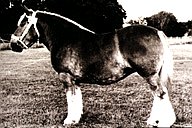
Origin: Denmark
Color: Commonly chestnut, black or bay, often with white markings on the face and legs, although sorrels, roans, and other colors also occur within the breed.
Avg Height: 15 to 16.1 hh
Avg Weight: 1500 to 1800 lbs
Build: Bears a marked resemblance to the Schleswig, whose origins are probably similar. The head, of proportionate size, is carried on a fairly short neck. The body, which is broad, round-ribbed, long, and very deep, has a pronounced dip at the saddle, a long sloping croup, and muscular loins and quarters. The sturdy, relatively short legs have some feather and the feet are large and rounded.
Temperament: Very docile but energetic.
Main use: Today the numbers are steadily decreasing. They are used mainly for sport/hobby, meat, and farming.
Special abilities: Traditional Danish draught horse. Dominant horse in Danish agriculture for almost a century. The action of the Jutland is quick and free, even though it is a medium-sized drafter.
History: The precise origins of this breed are uncertain, although a type of heavy warhorse is known to have existed in Denmark as long ago as the twelfth century. It is very similar to horses brought to Britain by the Vikings in the 9th and 10th centuries. Bred on the Jutland Peninsula from time immemorial, this heavy horse of Denmark was noted in the 12th Century for its sturdy build, which was capable of carrying an armored knight and endure the hardships of battle campaigns. During the Middle Ages, the Jutland was used for jousting tournaments, which indicates its strong constitution capable of sustaining the weight of the knight's armor. It has benefited from contributions from the Suffolk Punch and Cleveland Bay during the 19th Century, and more recently, from the Ardennais. The best of the present-day Jutlands are said to have descended from Oppenhein LXII, a dark-chestnut Suffolk Punch or Shire stallion imported from England in 1862. They were once used widely for agricultural work and heavy haulage. Today their numbers are steadily decreasing.
For Breeders, Farms, and Studs of this breed, click here.
If you have a horse of this breed, and you would like to see your pictures posted here, or if you would like to advertise your business that involves this particular breed, you can also email me.
I'm not perfect, and I never claim to be! If you see anything here that you believe I am wrong about, please feel free to email me. I might not agree with you, but at least I will listen!! :0) Can you fill in any of my blanks? Do you know of information or links that you would like to share with draft animal enthusiasts that you don't see here? Am I missing anything? Let me know at Draftladyb@yahoo.com.